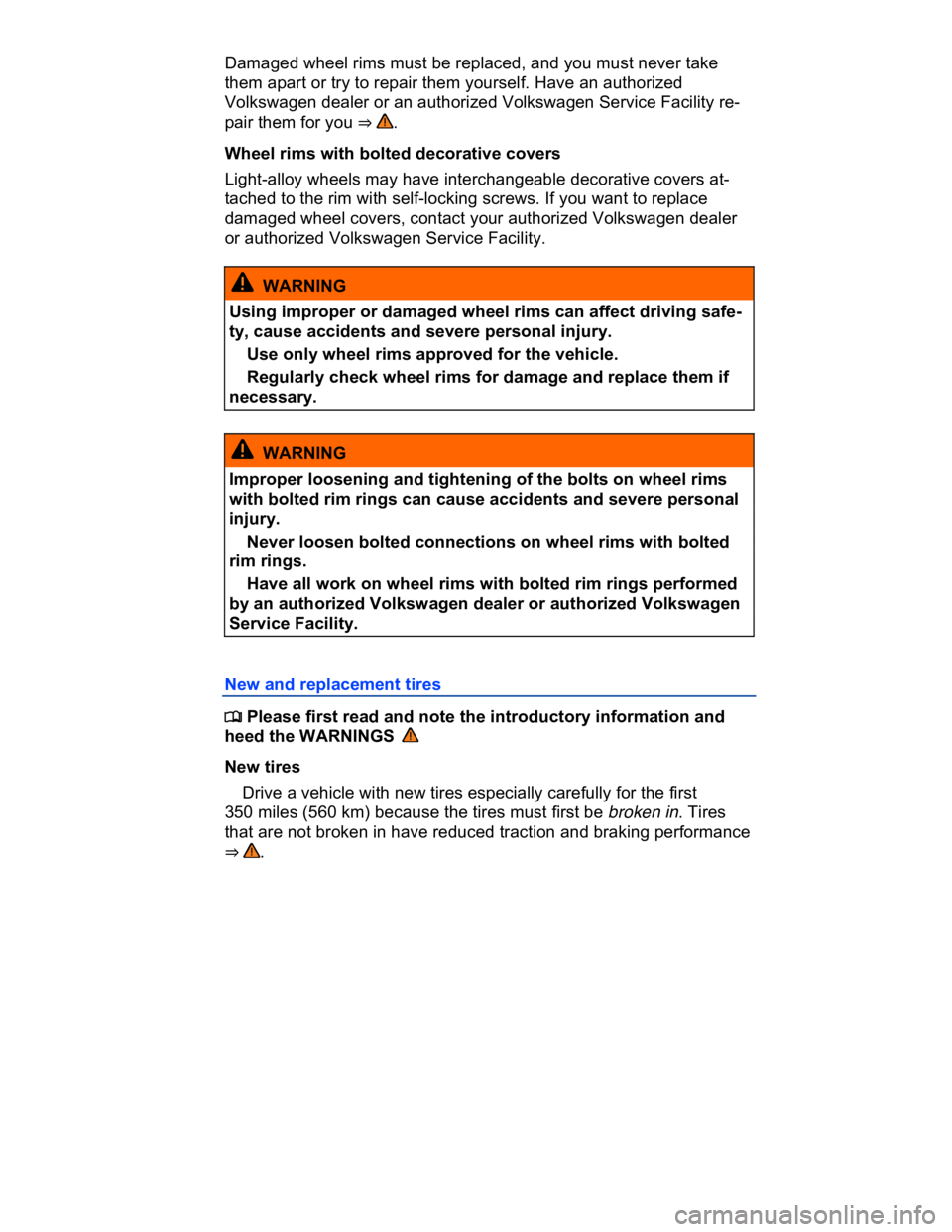Page 233 of 578

Damaged wheel rims must be replaced, and you must never take
them apart or try to repair them yourself. Have an authorized
Volkswagen dealer or an authorized Volkswagen Service Facility re-
pair them for you ⇒ .
Wheel rims with bolted decorative covers
Light-alloy wheels may have interchangeable decorative covers at-
tached to the rim with self-locking screws. If you want to replace
damaged wheel covers, contact your authorized Volkswagen dealer
or authorized Volkswagen Service Facility.
WARNING
Using improper or damaged wheel rims can affect driving safe-
ty, cause accidents and severe personal injury.
� Use only wheel rims approved for the vehicle.
� Regularly check wheel rims for damage and replace them if
necessary.
WARNING
Improper loosening and tightening of the bolts on wheel rims
with bolted rim rings can cause accidents and severe personal
injury.
� Never loosen bolted connections on wheel rims with bolted
rim rings.
� Have all work on wheel rims with bolted rim rings performed
by an authorized Volkswagen dealer or authorized Volkswagen
Service Facility.
New and replacement tires
�
Page 235 of 578

sure values stored in your vehicle's TPMS may have to be adjusted
(reprogrammed). This requires professional assistance. For more
information, contact your authorized Volkswagen dealer or authorized
Volkswagen Service Facility.
Installing replacement tires with steel cord body plies in the tire side-
wall may cause malfunction of the TPMS, and is not recommended
(cord material information in molded on the tire sidewall).
Always check the TPMS indicator light after replacing one or more
tires on your vehicle. If the indicator light is on, the TPMS is not work-
ing properly. Your replacement tire might be incompatible with the
system, or some component of the TPMS may be damaged.
For detailed information about TPMS, how it works and what you
need to know ⇒ Tire Pressure Monitoring System (TPMS).
WARNING
New tires tend to be slippery and must be broken in.
� Always drive with special care for the first 350 miles (560 km)
to help reduce the risk of losing control, a collision, and serious
personal injuries.
WARNING
Tires must have the required clearance. Tires that do not have
enough clearance can rub against parts of the vehicle body,
suspension, and brake system, causing brake system failure,
tread delamination, and sudden blowouts.
� Always make sure that new tires are not larger than the tires
approved for your vehicle and that the new tires do not rub
against parts of the vehicle.
NOTICE
� When switching to different tires, make certain the valves and
sensors are not damaged.
� Never drive without valve stem caps. The valves and sensors
could be damaged.
Page 247 of 578
NOTICE
When the spare wheel or compact spare is being used, the TPMS
indicator light can come on after a couple of minutes ⇒ Tire
Pressure Monitoring System (TPMS).
If possible, attach the spare wheel, compact spare wheel, or the
wheel you took off the vehicle securely in the luggage compartment.
Tire labeling
Fig. 116 International tire labeling.
�
Page 260 of 578

Speed rating (letter code)
A standardized letter code indicating the maximum speed at which a
tire is designed to be driven for extended periods of time. The ratings
range from 93 mph or 150 km/h (“P”) to 186 mph or (300 km/h) “Y”.
The speed rating letter code, where applicable, is molded on the tire
sidewall. You may not find this information on all tires because it is
not required by law.
Tire Pressure Monitoring System
A system that detects when at least one of a vehicle's tires is underin-
flated and illuminates a low tire-pressure warning light.
Tread
The portion of a tire that normally touches the road.
Tread rib
A tread section running circumferentially around a tire.
Tread separation
Tire failure caused by the tread pulling away from the tire carcass.
Tread wear indicators (TWI)
Raised areas within the main tread grooves that show, visually, when
tires are worn and near the end of their useful life ⇒ page 261.
Uniform Tire Quality Grading (UTQG)
A tire information system developed by the U.S. National Highway
Traffic Safety Administration (NHTSA) that is designed to help buyers
compare tires. UTQG is not a safety rating, nor is it a guarantee that a
tire will last for a certain number of miles or perform a certain way. It
gives tire buyers more information to compare with factors such as
price, brand loyalty and dealer recommendations. Under UTQG, tires
are graded by the tire manufacturers in 3 areas: tread wear, traction
and temperature resistance. UTQG information is molded into the tire
sidewalls.
U.S. DOT Tire Identification Number (TIN)
A tire's serial number. It begins with the letters “DOT” (“Department of
Transportation”) and indicates that the tire meets all federal stand-
ards. The next 2 numbers or letters indicate the plant where the tire
Page 271 of 578
There may be differences between the pressure readings from a
tire pressure gauge and the pressures registered by the Tire Pressure
Monitoring System. The electronic TPMS is more accurate.
If you have work done on your wheels or tires, inform the work-
shop that the vehicle is equipped with a Tire Pressure Monitoring
System that has sensors in the wheels.
Indicator light (telltale) �
Page 272 of 578
Lights
up
Display
text
Possible cause or
meaning ⇒
Proper response
�
Page 275 of 578
� If the tire is not “flat” and you do not have to change the tire
or wheel immediately, drive at reduced speed to the nearest
service station to check the tire pressure and add air as re-
quired.
� When replacing tires or wheel rims on vehicles equipped with
TPMS, always read and heed the information and all WARN-
INGS in the section ⇒ Tires and wheels.
WARNING
Failure to heed warning lights and instrument cluster text mes-
sages can cause the vehicle to break down in traffic and result
in a collision and serious personal injury.
� Never ignore warning lights or text WARNINGS.
� Always stop the vehicle as soon as it is safe to do so.
NOTICE
Failure to heed warning lights or text WARNINGS can result in
vehicle damage.
Tire Pressure Monitoring System (TPMS)
Fig. 117 Display screen in the instrument cluster: Current tire pres-
sures in psi.
�
Page 276 of 578

The Tire Pressure Monitoring System uses a pressure sensor in each
wheel. Signals from the sensors are transmitted to the TPMS.
The TPMS checks the tire pressure of all 4 tires while you are driving
and warns if there is a loss of pressure while the vehicle is moving.
Pressure loss that is 25% or more of the benchmark value pro-
grammed into the system is signaled by the indicator light (telltale)
described above, by acoustic warnings, and by text messages in the
instrument cluster display.
If you mount tires of a different size than the factory installed tires, an
authorized Volkswagen dealer or an authorized Volkswagen Service
Facility can adjust the benchmark TPMS tire pressure to match the
new tires. Without this adjustment, TPMS may not work correctly or at
all.
The tire pressure recommended for the tires originally installed on the
vehicle is on a sticker on the driver door jamb ⇒ Tire inflation pres-
sure.
Display in the instrument cluster
The display in the instrument cluster shows the vehicle with the actual
and benchmark tire pressures of all 4 road wheels ⇒ fig. 117
Tire pressure display screen
⇒ fig. 117 Meaning
(1) Tire pressure warning, left rear
tire.
(2) Current tire pressure, front left
tire.
(3) Benchmark pressure, front tires
(4) Current tire pressure, front right
tire.
(5) No data received, right rear tire.
(6) Benchmark pressure, rear tires